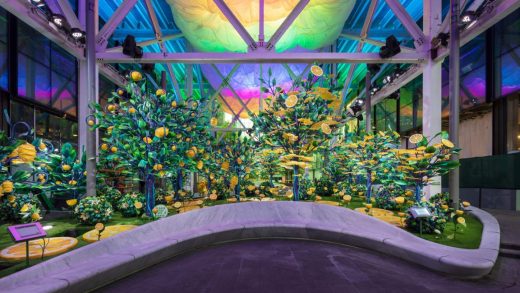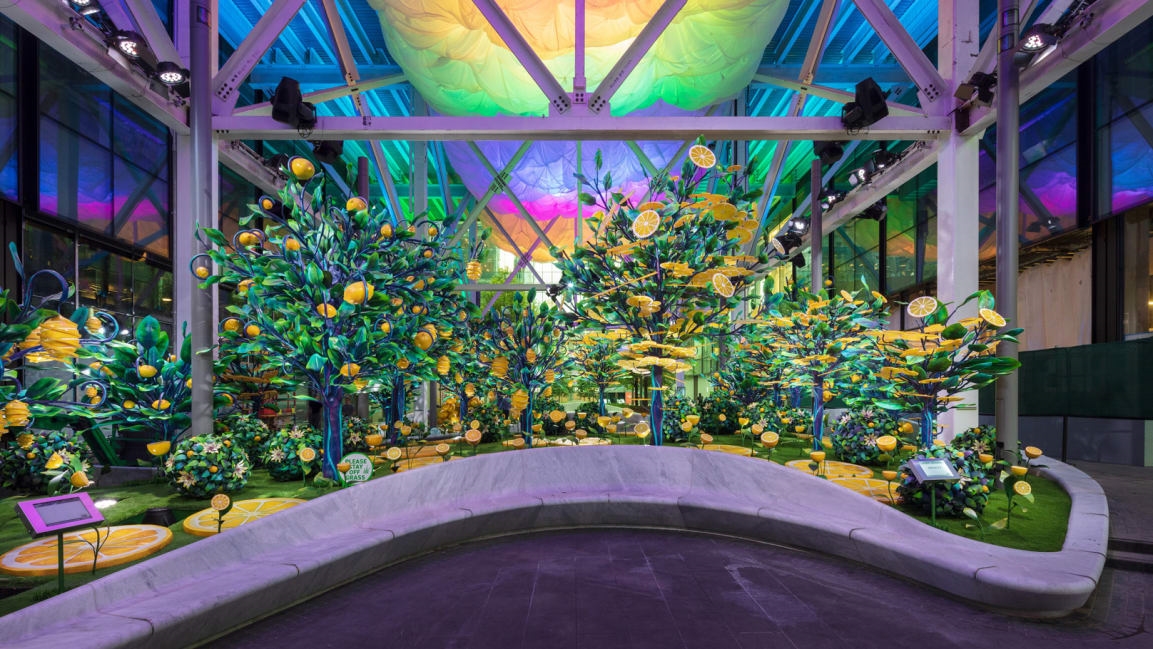The fantastical way one developer is reimagining NYC’s miserable construction sites
It could have been just another typical New York sight: a framework of steel scaffolding built on the sidewalk below a massive construction project. Required by the city to protect pedestrians from falling debris, these so-called construction sheds are often more like cramped cages overtaking the sidewalk and funneling humans through the city like oversized rats.
To protect pedestrians walking through its $5 billion mega-development Manhattan West, the developer Brookfield Properties made the uncommon move of turning its construction shed into an extravagant spectacle. Covering an area the size of a football field, the protected space beneath the giant new shed has become a lemon-themed wonderland.
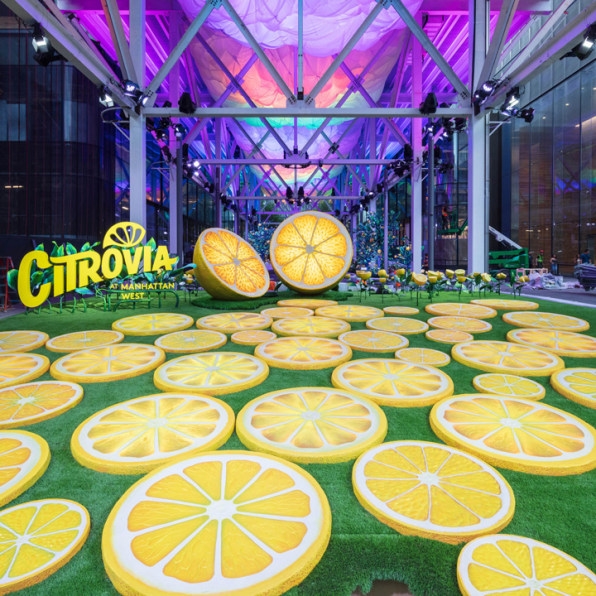
Dubbed Citrovia, the space is decked out with oversized artificial lemons, lemon trees, and lemon slices by the hundreds, as well as seating, a fabric “cloud” featuring hourly light shows, and a series of augmented reality experiences that aim to make this otherwise avoidable space a place people might actually go on purpose.
It’s a gimmick, undeniably, but one that taps into emerging ideas about what to do with the temporarily unpleasant parts of cities-in-progress.
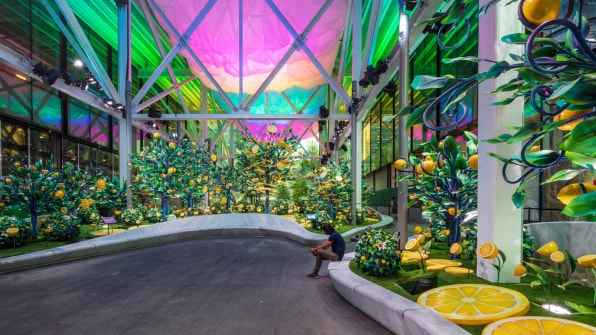
Manhattan West is spread over eight acres near Hudson Yards, the new Moynihan Train Hall at Penn Station, and a forthcoming extension of the High Line. Built over a former railyard, the project will include a 62-story residential tower, 6 million square feet of office space in four other buildings, and a 164-room hotel. Part of the superblock complex is complete, and part is still being built; the entire project is expected to finish in 2023.
Part of that ongoing construction project is a 58-story office tower designed by Skidmore, Owings, and Merrill and set to open in 2023. The tower sits alongside a two-acre open-air public plaza designed by the landscape architecture firm James Corner Field Operations, which is flanked by more than 20 restaurants, bars, and retail shops – all of which are set to open in September, during construction.
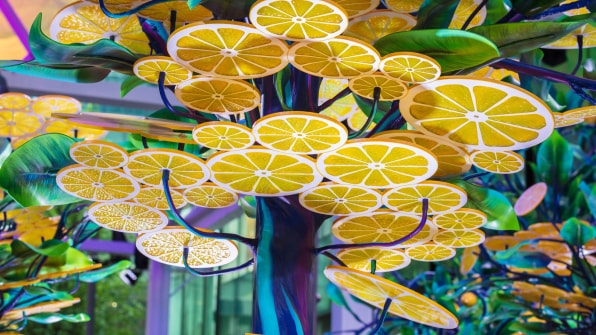
To enable these businesses to function under the shadow and cage of a construction site, Brookfield erected a giant construction shed 40 feet high and covering roughly the entire two acre plaza. The lemon theme park idea, according to Brookfield senior vice president of marketing Sara Fay, is partly a way to activate the space, partly a play at user-generated buzz about the project via social media, and a heavy dose of “why not?”
“We really wanted this to surprise and delight and not take itself too seriously,” Fay says. “This is not fine art, this is meant to be Instagrammable, it’s meant to be fun.”
The whimsical forest features fake lemon trees up to 19 feet tall, 700 lemons and slices ranging up to 6 feet in diameter, and about 4,500 hand-painted leaves. Fay says the company looked to Disney theme parks for inspiration, and partnered with interactive design studio The Cuttlefish to develop the lemon world and its augmented reality aspects. The pieces were fabricated by Adirondack Studios, which builds theme park rides and sets for Broadway shows. Brookfield also brought in the nonprofit Salvadori Center to produce an educational booklet for children exploring themes of size, scale, and proportion – with oversized lemons as its guiding characters. Brookfield declined to disclose the project’s budget. The spectacle, which is free and open to the public, will remain active until construction on the entire project is complete in 2023.
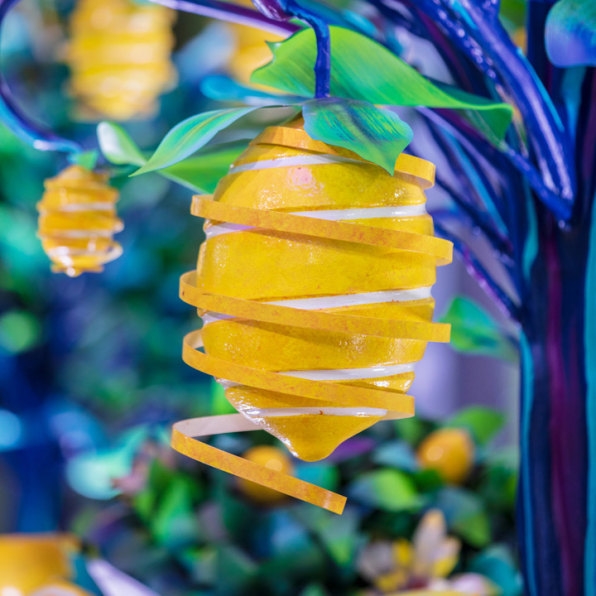
Though Citrovia’s over-the-topness is unusual, the concept behind the project is becoming common in urban settings, particularly in England. Known in London as “meanwhile uses,” these kinds of temporary activations and public projects are increasingly installed on vacant sites or development and construction areas. Portions of in-progress construction sites, or “carved spaces,” have been given meanwhile uses ranging from parks to community gardens to shopping areas. Some meanwhile projects, like the shipping container pop-up Boxpark mall in London’s Shoreditch neighborhood, have become permanent. One organization, the Meanwhile Foundation, has even specialized in taking vacant properties and storefronts and using them to generate socioeconomic value.
At Citrovia, the socioeconomic value of lemon-based Instagram posts is arguably low, but the project could be helping to introduce the concept of meanwhile use in the U.S.
Given Manhattan West’s scale and location, Fay says the far-out worldbuilding of Citrovia is ultimately a one-off. But she says Brookfield is likely to make other smaller-scale efforts to rethink and reframe the avoidable or unpleasant spaces near construction projects. “I do think that we will continue to do this type of thing in terms of activating public space, and I think it’s certainly additive to any project,” she says.
That may not take the form of a fantastical lemonscape, nor will it necessarily generate the kind of buzz that marketing departments desire, but it could lead to some underutilized urban space finding new life. At the very least, developers can think about these kinds of meanwhile uses as a way to reduce the downsides of the months or years it takes to build their projects. They may even generate a little goodwill in the process. “I think it is beneficial for other landlords to be thinking about this,” Fay says.
(13)

